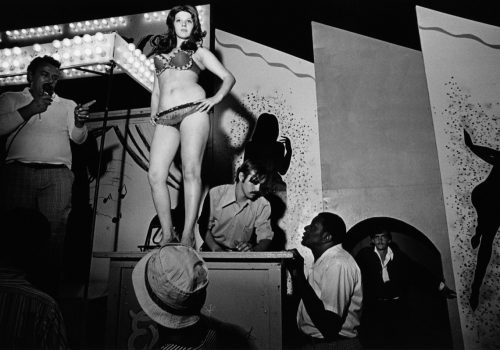The Danziger Gallery in New York is showing the photographs that launched this documentary photographer’s career.
Susan Meiselas crossed paths with carnival strippers during a road trip in New England with her husband Richard p. Rogers – a documentary director known for having studied American culture and its social classes in his films. It was the summer of 1972. She was amazed by the signs “Women and children not allowed” at the entrances to the tents, alongside those who performed there, but she would wait until the following year to be invited into their dressing rooms and record the conversations she had with them. “At that time, the feminists considered it (i.e. the circus) a place where women were exploited and were victims”, she wrote in the retrospective book recently published by Xavier Barral.
In fact, when it was first published in 1976, the book Carnival Strippers was described as “depressing” even though the critics praised the light it shone on the world hidden behind the heavy curtains. Meiselas followed a group of strippers who performed at fairs in small town in new England, Pennsylvania and South Carolina. In it can be read some extracts of the testimonies collected by Meiselas during the three years that she spent following the women on their seasonal tour. This is Lena, who explains, without make-up, “I actually got sick to my stomach the first time I went down and let somebody eat me out. I came back here and puked and then I said, ‘Now I got to do it’, and I did it. I won’t make a habit of it, this is the only spot I’ll ever do it in. […] And all those girls on all those stages are assholes.”
This series quickly defined Meiselas’ approach, making the photography a fully participatory medium. For her study project “44 Irving Street” she shared her portraits with her subjects, inviting them to talk about themselves, and reproducing the exercise. “My embryonic ethnographic studies encouraged me to follow this path. […] Without doubt it’s one of the reasons the great street photographers’ way of working wasn’t suitable for me. I needed to share what I had seen by giving it back to the subject I’d photographed”, she writes.
Little by little she bonded with these women and used different angles. At first, she positioned herself facing the stage, melting in to the crowd of men entranced by the brief performance. From there she was a spectator, just as they were, and those who would see her images later. And the women seemed to pose, proud and unshakeable. It’s the rest of her images that would capture their motivations, their personalities, “their individual psychological spaces”, to use Meiselas’ words. She slipped backstage to capture the spectators, their dreamy look, fascinated and excited by the naked bodies. Then came the opposite of being on stage, the breaks in the dressing rooms before going on stage, the faces where the fatigue, the doubt and sometimes the disgust could be read, but also the tenderness and closeness of bodies rubbing shoulders between two performances.
Laurence Cornet
Laurence Cornet is a journalist specialising in photography She is also an independent curator. She lives between New York and Paris.
Susan Meiselas, Carnival Strippers
Until 3rd March 2018
Danziger Gallery
95 Rivington Street
New York, NY 10002
USA
















